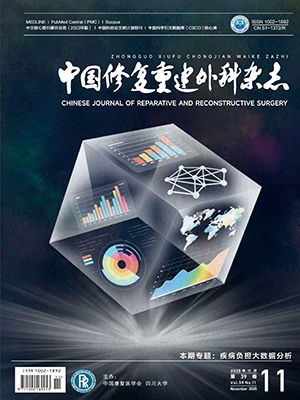| 1. |
Malandrino A, Lacroix D, Hellmich C, et al. The role of endplate poromechanical properties on the nutrient availability in theintervertebral disc. Osteoarthritis Cartilage, 2014, 22(7):1053-1060.
|
| 2. |
Gu W, Zhu Q, Gao X, et al. Simulation of the progression of intervertebral disc degeneration due to decreased nutritional supply. Spine (Phila Pa 1976), 2014, 39(24):E1411-1417.
|
| 3. |
Tim Yoon S, Su Kim K, Li J, et al. The effect of bone morphogenetic protein-2 on rat intervertebral disc cells in vitro. Spine (Phila Pa 1976), 2003, 28(16):1773-1780.
|
| 4. |
Peng Y, Kang Q, Luo Q, et al. Inhibitor of DNA binding/differentiation helix-loop-helix proteins mediate bone morphogenetic protein-induced osteoblast differentiation of mesenchymal stem cells. J Biol Chem, 2004, 279(31):32941-32949.
|
| 5. |
Du Y, Yip H. Effects of bone morphogenetic protein 2 on Id expression and neuroblastoma cell differentiation. Differentiation, 2010, 79(2):84-92.
|
| 6. |
Urban JP, Smith S, Fairbank JC. Nutritionof theintervertebral disc. Spine (Phila Pa 1976), 2004, 29(23):2700-2709.
|
| 7. |
Roberts S, Menage J, Urban JP. Biochemical and structural properties of the cartilage end-plate and its relation to the intervertebral disc. Spine (Phila Pa 1976), 1989, 14(2):166-174.
|
| 8. |
Aigner T, Gresk-Otter KR, Fairbank JC, et al. Variation with age in the pattern of type X collagen expression in normal and scoliotic human intervertebral discs. Calcif Tissue Int, 1998, 63(3):263-268.
|
| 9. |
徐宏光, 楊名, 王弘, 等. 頸椎軟骨終板ANK的表達變化. 中華醫學雜志, 2010, 90(17):1192-1196.
|
| 10. |
M??tt? JH, Wadge S, MacGregor A, et al. Vertebral endplate (modic) change is an independent risk factor for episodes of severe and disabling low back pain. Spine (Phila Pa 1976), 2015, 40(15):1187-1193.
|
| 11. |
Neidlinger-Wilke C, Boldt A, Brochhausen C, et al. Molecular interactions between human cartilaginous endplates and nucleus pulposus cells:a preliminary investigation. Spine (Phila Pa 1976), 2014, 39(17):1355-1364.
|
| 12. |
Wu Y, Cisewski S, Sachs BL, et al. Effect of cartilage endplate on cell based disc regeneration:a finite element analysis. Mol Cell Biomech, 2013, 10(2):159-182.
|
| 13. |
Norton JD, Deed RW, Craggs G, et al. Id helix-loop-helix proteins in cell growth and differentiation. Trends Cell Biol, 1998, 8(2):58-65.
|
| 14. |
胡有谷, 陳伯華. 椎間盤退變基因治療進展. 中國骨與關節外科, 2013, 6(Suppl 1):11-16.
|
| 15. |
Moon SH, Nishida K, Gilbertson LG, et al. Biologic response of human intervertebral disc cells to gene therapy cocktail. Spine (Phila Pa 1976), 2008, 33(17):1850-1855.
|
| 16. |
Li J, Yoon ST, Hutton WC. Effect of bone morphogenetic protein-2(BMP-2) on matrix production, other BMPs, and BMP receptors in rat intervertebral disc cells. J Spinal Disord Tech, 2004, 17(5):423-428.
|
| 17. |
Kim DJ, Moon SH, Kim H, et al. Bone morphogenetic protein-2 facilitates expression of chondrogenic, not osteogenic, phenotype of human intervertebral disc cells. Spine (Phila Pa 1976), 2004, 28(24):2679-2684.
|
| 18. |
Neumann AJ, Gardner OF, Williams R, et al. Human articular cartilage progenitor cells are responsive to mechanical stimulation and adenoviral-mediated over expression of bone-morphogenetic protein 2. PLoS One, 2015, 10(8):e0136229.
|
| 19. |
Peng Y, Kang Q, Luo Q, et al. Inhibitor of DNA binding/differentiation helix-loop-helix proteins mediate bone morphogenetic protein-induced osteoblast differentiation of mesenchymal stem cells. J Biol Chem, 2004, 279(31):32941-32949.
|
| 20. |
Desprez PY, Lin CQ, Thomasset N, et al. A novel pathway for mammary epithelial cell invasion induced by the helix-loop-helix protein Id-1. Mol Cell Biol, 1998, 18(8):4577-4588.
|
| 21. |
Ling MT, Lau TC, Zhou C, et al. Overexpression of Id-1 in prostate cancer cells promotes angiogenesis through the activation of vascular endothelial growth factor VEGF. Carcinogenesis, 2005, 26(10):1668-1676.
|
| 22. |
Sakurai D, Tsuchiya N, Yamaguchi A, et al. Crucial role of in hibitor of DNA binding/differentiation in the vascular endothelial growth factor-induced activation and angiogenic processes of human endothelial cells. J Immunology, 2004, 173(9):5801-5809.
|




